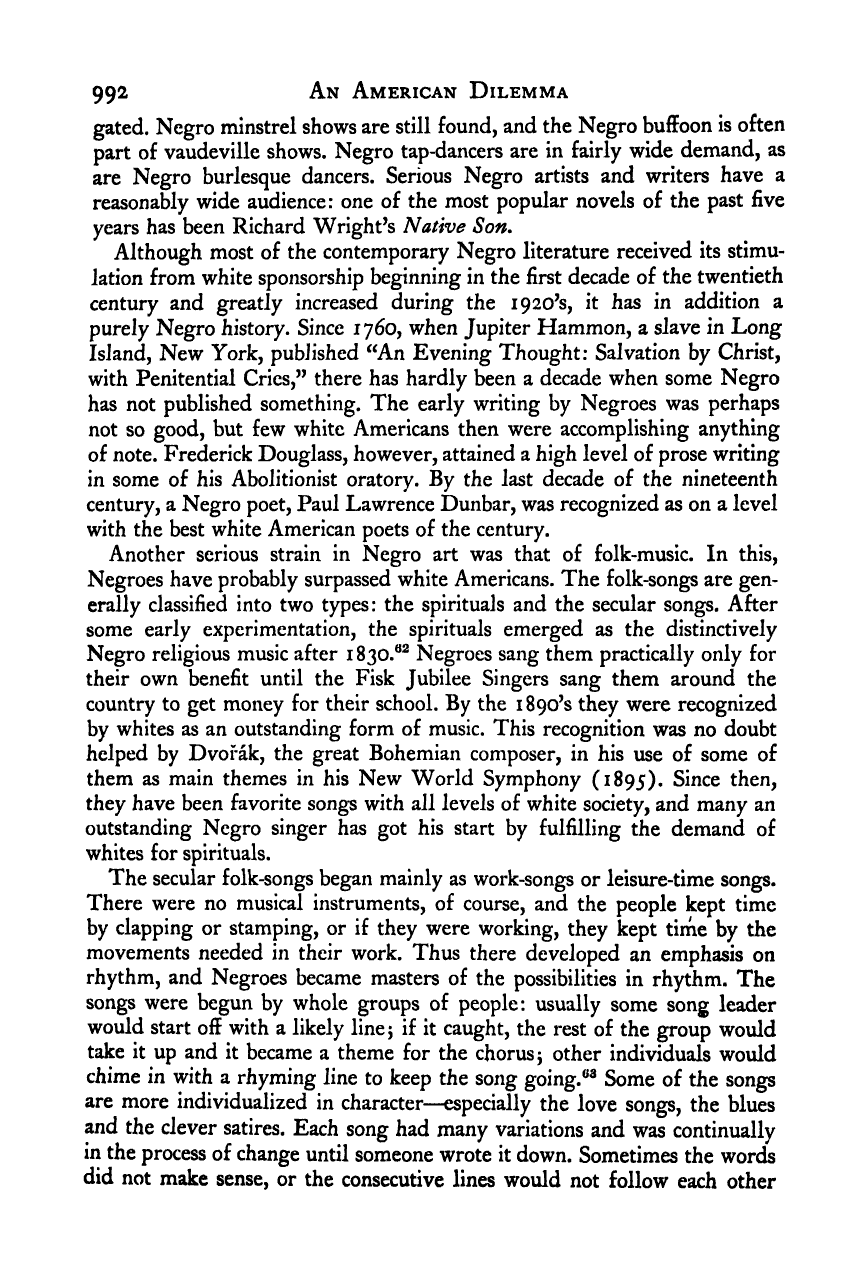Note: Gunnar Myrdal died in 1987, less than 70 years ago. Therefore, this work is protected by copyright, restricting your legal rights to reproduce it. However, you are welcome to view it on screen, as you do now. Read more about copyright.
Full resolution (TIFF) - On this page / på denna sida - X. The Negro Community - 44. Non-Institutional Aspects of the Negro Community - 5. Negro Achievements

<< prev. page << föreg. sida << >> nästa sida >> next page >>
Below is the raw OCR text
from the above scanned image.
Do you see an error? Proofread the page now!
Här nedan syns maskintolkade texten från faksimilbilden ovan.
Ser du något fel? Korrekturläs sidan nu!
This page has never been proofread. / Denna sida har aldrig korrekturlästs.
992 An American Dilemma
gated. Negro minstrel shows are still found, and the Negro buffoon is often
part of vaudeville shows. Negro tap-dancers are in fairly wide demand, as
are Negro burlesque dancers. Serious Negro artists and writers have a
reasonably wide audience: one of the most popular novels of the past five
years has been Richard Wright’s Native Son.
Although most of the contemporary Negro literature received its stimu-
lation from white sponsorship beginning in the first decade of the twentieth
century and greatly increased during the 1920’s, it has in addition a
purely Negro history. Since 1760, when Jupiter Hammon, a slave in Long
Island, New York, published ^^An Evening Thought; Salvation by Christ,
with Penitential Cries,” there has hardly been a decade when some Negro
has not published something. The early writing by Negroes was perhaps
not so good, but few white Americans then were accomplishing anything
of note. Frederick Douglass, however, attained a high level of prose writing
in some of his Abolitionist oratory. By the last decade of the nineteenth
century, a Negro poet, Paul Lawrence Dunbar, was recognized as on a level
with the best white American poets of the century.
Another serious strain in Negro art was that of folk-music. In this,
Negroes have probably surpassed white Americans. The folk-songs are gen-
erally classified into two types: the spirituals and the secular songs. After
some early experimentation, the spirituals emerged as the distinctively
Negro religious music after 1830.®^ Negroes sang them practically only for
their own benefit until the Fisk Jubilee Singers sang them around the
country to get money for their school. By the 1890’s they were recognized
by whites as an outstanding form of music. This recognition was no doubt
helped by Dvorak, the great Bohemian composer, in his use of some of
them as main themes in his New World Symphony (1895). Since then,
they have been favorite songs with all levels of white society, and many an
outstanding Negro singer has got his start by fulfilling the demand of
whites for spirituals.
The secular folk-songs began mainly as work-songs or leisure-time songs.
There were no musical instruments, of course, and the people kept time
by clapping or stamping, or if they were working, they kept time by the
movements needed in their work. Thus there developed an emphasis on
rhythm, and Negroes became masters of the possibilities in rhythm. The
songs were begun by whole groups of people: usually some song leader
would start off with a likely linej if it caught, the rest of the group would
take it up and it became a theme for the chorus j
other individuals would
chime in with a rhyming line to keep the song going. Some of the songs
are more individualized in character—especially the love songs, the blues
and the clever satires. Each song had many variations and was continually
in the process of change until someone wrote it down. Sometimes the words
did not make sense, or the consecutive lines would not follow each other
<< prev. page << föreg. sida << >> nästa sida >> next page >>